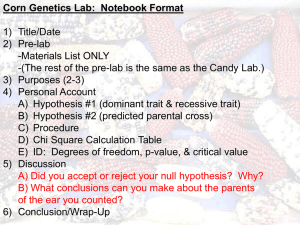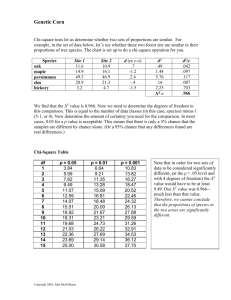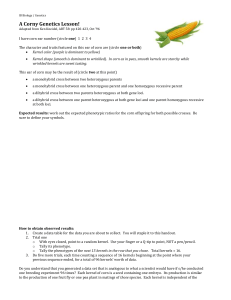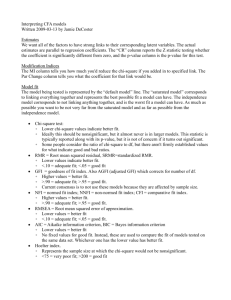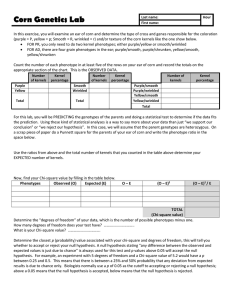Corn Genetics
advertisement
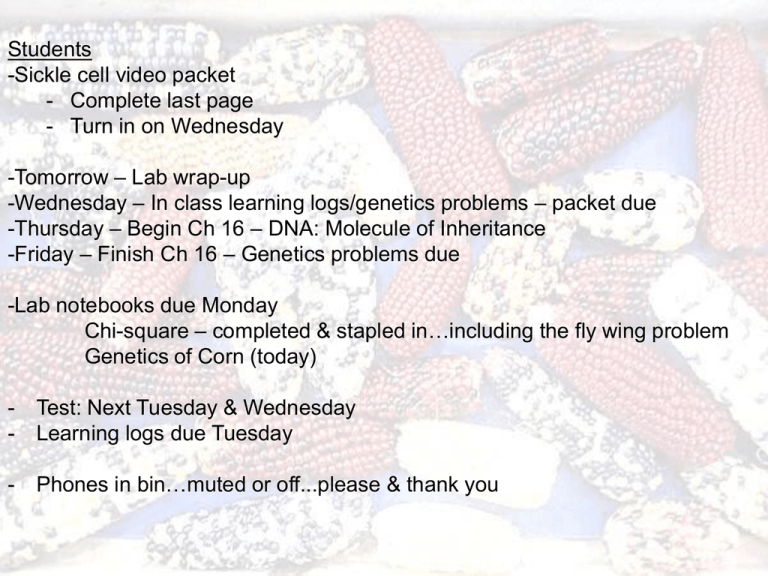
Students -Sickle cell video packet - Complete last page - Turn in on Wednesday -Tomorrow – Lab wrap-up -Wednesday – In class learning logs/genetics problems – packet due -Thursday – Begin Ch 16 – DNA: Molecule of Inheritance -Friday – Finish Ch 16 – Genetics problems due -Lab notebooks due Monday Chi-square – completed & stapled in…including the fly wing problem Genetics of Corn (today) - Test: Next Tuesday & Wednesday Learning logs due Tuesday - Phones in bin…muted or off...please & thank you Lab 7 alternative: Genetics of Corn – playing the role of Mendel 1. 2. 3. 4. Each set of partners should obtain one ear of corn. Study the ear and select 2 different traits that are easy to recognize. Make a chi-square table with the 4 possible phenotypes. Categorize the kernels on the entire ear by using tally marks for each of the 4 phenotypes. Use 1 pin to mark the row that you started on and another to mark the current row you are counting. 5. Count your tallies and record your data in the chi-square table. 6. Based on your observations of kernels and the ratios you counted, hypothesize which traits are dominant & which are recessive. Then hypothesize who the parents were that created the ear that you just counted. (This is basically what Mendel had to do with the peas.) This will allow you to predict a ratio/number of offspring from the total number of kernels counted. 7. Complete your chi-square table & calculate chi-square by including your null hypothesis, degrees of freedom and p value. Critical Values of the Chi-Square Distribution Degrees of Freedom (df) Probability (p) 1 2 3 4 5 0.05 3.84 5.99 7.82 9.49 11.1 0.01 6.64 9.21 11.3 13.2 15.1 0.001 10.8 13.8 16.3 18.5 20.5 Lab 7 alternative: Genetics of Corn – playing the role of Mendel 1. 2. 3. 4. 5. 6. 7. 8. 9. Each set of partners should obtain one ear of corn. Study the ear and select 2 different traits that are easy to recognize. Make a chi-square table with the 4 possible phenotypes. Categorize the kernels on the entire ear by using tally marks for each of the 4 phenotypes. Use 1 pin to mark the row that you started on and another to mark the current row you are counting. Count your tallies and record your data in the chi-square table. Based on your observations of kernels and the ratios you counted, hypothesize which traits are dominant & which are recessive. Then hypothesize who the parents were that created the ear that you just counted. (This is basically what Mendel had to do with the peas.) This will allow you to predict a ratio/number of offspring from the total number of kernels counted. Complete your chi-square table & calculate chi-square by including your null hypothesis, degrees of freedom and p value. Did you accept or reject your null hypothesis? What conclusions can you make about the parents of the ear you counted? (This is THE Discussion Question.) Students -Get -Math handout - optional -test folders -This is your period to work on -Lab notebooks – on the shelf -Genetics problems – in the box -Learning Logs – Due Monday -So….”Free day, have fun, get work done” -Cans and Carols Concert at Redeemer Presbyterian Church! -Sunday 12/7 -1046 Miller Street Winston Salem -6 pm to whenever :P -Admission is canned goods and/or dry food -Cell phones in bin….off or muted…please & thank you After a translocation event affecting chromosome 22, a gene can be activated that codes for an intracellular kinase. Review the discussion of cell cycle control and cancer in Chapter 12, and explain how the activation of this gene could contribute to the development of cancer. (CUES: phosphorylation, mitosis, activation, tumor) CDK stays active even if cyclin is not there because of the Translocation. The active kinase aids in phosphorylation which Leads to the activation of mitosis and progression through the cell cycle. The increase in mitosis would lead to extreme cell growth And the formation of a tumor.
